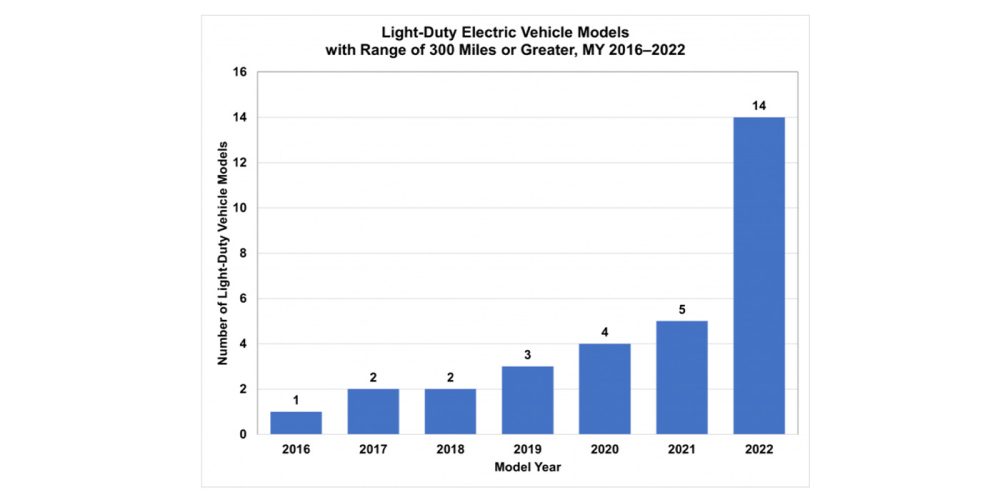
According to the “fact of the week” from the United States Department of Energy, the number of EVs offering at least 300 miles of range has grown tremendously since 2016 and has tripled in 2022 compared to a year prior. Higher range remains a huge selling point for US consumers, but still begs the question – is it really necessary for the average driver?
In the past, we at Electrek have done our best to disperse the fog of many myths and assumptions that often surround EVs and stifle their adoption. One of the biggest hurdles that still intimidatingly sits as a roadblock to many consumers is range anxiety.
Although every driver today is used to filling their tank with gasoline while remaining conscious of their fuel levels to ensure they don’t run out, the general population shares a crippling fear that they will run out of range in an EV and be stranded in the middle of nowhere… probably forever.
That’s unequivocally untrue, especially in this day and age. Consumers no longer have to deal with EV range anxiety that was once hardened by early EVs like the Nissan LEAF. The pushing of the range envelope, like many EV technologies in the 2010s, was led forward by Tesla, who at a point, was the only EV automaker offering vehicles with 300 miles of range or more.
The 2020s are different. The rest of the industry has caught up, and consumers have more options than ever that not only provide more than adequate EV range, but offer much more style and function than they are used to.
Recent data from the US Department of Energy shows that the number of EVs with over 300 miles of range has begun to snowball. Good for EV adoption, yes, but absolutely necessary when purchasing a new EV? Probably not. Let’s have a look.

2022 model year saw 14 EVs with range over 300 miles in US
As you can see from the chart above from the US Dept. of Energy’s “fact of the week,” the number of 2022 model year EVs in the US nearly tripled compared to just five in 2021. This increase is accentuated when you compare that same number to five years ago, when only one EV on the market delivered that sort of range.
Tesla’s EVs dominated in range in the early years of the chart, but have since been met with a lot more competition from EV automakers new and old. Here are all fourteen 2022 EVs that promise an EPA certified range of 300 miles or more.
| 2022 Model Year EV | Range |
| BMW iX | Up to 324 miles |
| BMW i4 | Up to 301 miles |
| Ford F-150 Lightning | Up to 320 miles |
| Ford Mustang Mach-E | Up to 314 miles |
| Hyundai IONIQ 5 | Up to 303 miles |
| Kia EV6 | Up to 310 miles |
| Lucid Air | Up to 520 miles |
| Mercedes-Benz EQS | Up to 350 miles |
| Rivian R1T | Up to 400+ miles |
| Rivian R1S | Up to 400+ miles |
| Tesla Model S | Up to 405 miles |
| Tesla Model X | Up to 348 miles |
| Tesla Model 3 | Up to 315 miles* |
| Tesla Model Y | Up to 330 miles |
Not a bad selection to choose from. While many of these EV models are on the higher end, there are plenty of more affordable options like the Hyundai IONIQ 5, Kia EV6, and Ford F-150 Lightning (if you’re willing to wait until 2024 for one).
As automakers develop more advanced EV platform technology filled with lighter and more energy dense battery cells, we should continue to see increases to range that will trickle down to more affordable models.
Still, many consumers don’t have the money to afford a lot of the 2022 models on the list above and that’s quite alright, especially if you’re looking to buy one of them based on their EV range. Ask yourself, “When was the last time I drove 300 miles straight?”
It’s also important to remember that the average work commute in the US remains far less than 100 miles per day, meaning you can plug in at the office, or better yet, at home during off-peak hours while you sleep.
While more range is of course welcome and will more than likely continue to expand to more and more EVs going forward, it shouldn’t necessarily be a dealbreaker in your purchase decision. Here are some additional resources to help you decide what EV model might be the best for you and your driving needs:
- Survey says consumers avoid electric cars due to three myths: range, price, charging
- Longest-range electric vehicles (EVs) you can buy in 2021
- The top 10 fastest-charging EVs currently available
- Tracking the most affordable EV leases in 2022
- The best (and worst) US states for EV charging
- How to get the most range out of your Tesla
Subscribe to Electrek on YouTube for exclusive videos and subscribe to the podcast.
Author: Scooter Doll
Source: Electrek



